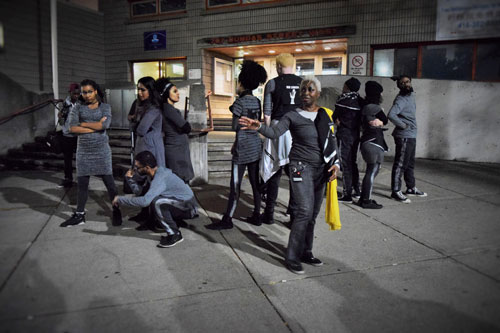
In 1991 b current launched and brought to life ahdri zhina mandiela’s Dark Diaspora… In Dub. 25 years later, they’re revisiting this with a parading event and visual installation called diaspora Dub, taking place on three separate nights, in three separate venues.
I had the chance to ask artistic director Jajube Mandiela some questions about the event, and here’s what she had to say:
Can you talk a bit about b current? Your history, mission, etc?
b current was founded in 1991, as a place for Black women artists to develop and produce their new plays. The catalyst for founding Artistic Director ahdri zhina mandiela to launch the company was the production of her piece ‘dark diaspora… in dub’.
Over its 25 year history, b current grew to be a home for Black women, men and other Artists of Colour to professionally train in Black diasporic methods through the rAiz’n the Sun training program, and develop and produce their new works.
The company has trained phenomenal artists including celebrated storyteller and poet d’bi young, ‘Da Kink in My Hair’ creator Trey Anthony, Governor General Award Finalist Joseph Jomo Pierre, director Weyni Mengesha, Dora Award winning actor Raven Dauda, Poet/Playwright/Screenwriter Motion, and ‘Degrassi’ alum and current Artistic Director Jajube Mandiela.
Along with main stage hit ‘Obeah Opera‘ (2012), b current has run the rock.paper.sistahz theatre festival since 2002, and afteRock Plays, a co-producing series since 2013.
b current‘s mission is to make theatre by Black and other Artists of Colour an integral — rather than niche — part of the Canadian cultural landscape, all the while committed to culturally-rooted artistic forms authentic to these theatre-makers (and alternatives to Eurocentric forms).
Our new training program, the bcHub, is the spine of the company, empowering and training professional Black and other Artists of Colour to create/perform and produce their own works across the country.
Can you talk about this event specifically — both the original dark diaspora… in dub, and the remake — and why you chose to remake it?The original ‘dark diaspora… in dub’ was the first of its kind, the world’s first staging of a dub theatre script.
For a small, alternative Black-focused company (a rarity in the theatre community), to be around 25 years later is a huge feat in itself, and to be able to share the company’s legacy through the still-thriving genre of dub theatre is a way to go back in time and be boldly in the present as well.
I chose to program this current reimagining as a celebration of b current, and of Black people’s contribution to Toronto and Canada over the past 25 years.
What can audiences expect during these performances? Any surprises or unusual elements given the varying venues and times?
Audiences can expect street-meets-venue theatre, a mix of polished and raw, a parading low-pressure participatory experience. The audience will get to experience this mass force of over a dozen artists who identify as Black and other People of Colour, with their Canadian-ness and their own cultural roots infused into — and taking over — these different venues in body and sound.
Did being a part of the greater Nuit Blanche event change anything artistically or practically?
So much positivity from launching diaspora Dub on the night of Nuit Blanche; Some people specifically came for diaspora Dub, and many audience members happened upon the parading, engaging celebration. One person told us that we turned her miserable mood into joy with our exuberant, positive energy and story of enduring spirit.
Ideally, how would you like to see b current – and Black arts in general – grow?
I would like to see b current grow to be a staple of Toronto’s culture, as a go-to place for artists and audiences craving culturally-rooted training, new play development, and producing: For b current to be a champion for Canadian culture that is truly inclusive of people’s cultural origins.
I would like Black arts in Canada to be as numerous in form and content as the people, along with pioneering new forms; With culturally-rooted works, mixing forms, content on North American and African experiences, the Caribbean, Central and South America and beyond.
Details
- diaspora Dub is playing until October 9, 2016 at various locations
- Please see website for show times, dates, and locations
- Ticket prices range from Free – $30 and are available online
Photo by Shaista Latif
